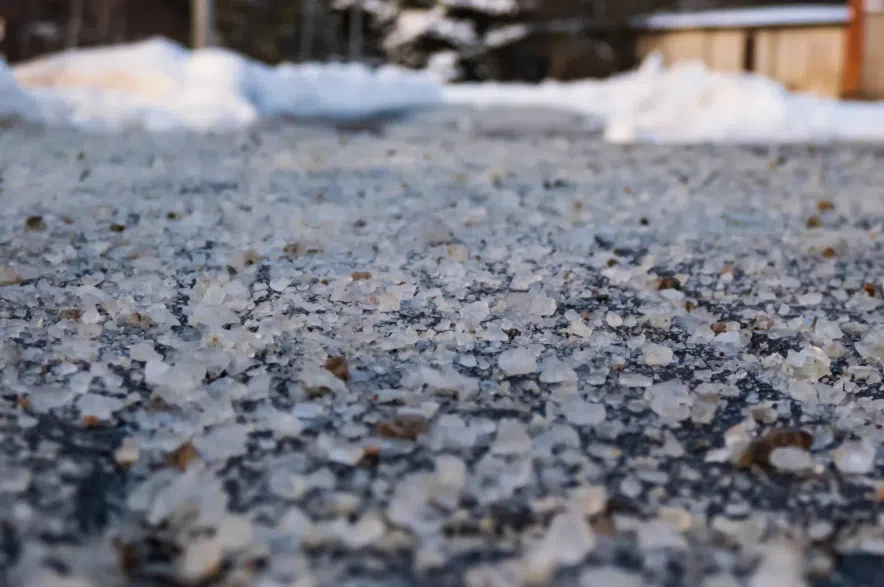Jill and Rick Van Duyvendyk answer all your gardening questions in Garden Talk on 650 CKOM and 980 CJME every Sunday morning at 9 a.m. Here are some questions and answers from the Nov. 23 show:
Read more:
- Garden Talk: What do I need to know about grow lights?
- Garden Talk: How to protect your precious potted peonies over winter
- Garden Talk: Tips to help your Christmas cactus bloom
These questions and answers have been edited and condensed for clarity.
Q: What do I need to know about snow melt products and salt?
A: You want to look for a salt that is more environmentally friendly. Regular rock salt is pretty harsh on everything, including landscaping surfaces like concrete. Even getting it on your feet and walking indoors can damage interior hardwood floors.
If you have perennials beside your sidewalk and shovel snow mixed with salt into the bed, it will kill them, so look for that type of salt that helps the plants survive any buildup of salts.
If you just use a tiny little bit, it’s not bad, but if you start pouring it on, it’s even going to kill the grass alongside the driveway.
A mix using beet pellets can be used instead of salt. Some commercial applications are using beet juice or sugar cane liquid. Salt, beet and sugar cane mixes can only be used down to around -10 C to -18 C, at -40 C it’s not going to work.
Q: How do I protect perennials that are regrowing now that the weather is getting cold?
A: If they have grown too much and you might lose some of the blooming power for next year but you’re probably not going to lose the plant.
Put some insulation or mulch over top and they will die back down and then in the spring you can cut them back down to ground level and they’ll probably grow back for you.
Slow down on any watering maybe a little bit earlier next year so that they can shut down a little bit faster.
Q: How do I keep a potted canna lily over winter?
A: Wait for it to die back, don’t water it, and then cut it off, then lift it out of the pot. You can leave it in the pot, but it’s likely to not grow further if you take it out of the pot and store it in a cold storage area.
You can even put it in a crisper of a fridge away from any any vegetables or fruits or in a dark corner of a basement or a corner of the garage, and put some insulation around it.
It’s just a bulb so if you are to lift it out of the soil, clean it off, clean some of the extra roots and store it in a paper bag with some peat moss or sawdust.
Q: What can I grow in winter under grow lights?
A: Leafy greens, herbs and lettuce and even sprouts are ideal things to grow indoors because they have such a short lifespan to get them to their full size, so you’re not needing to provide them with the nutrients for a long period of time. With grow lights they will grow in about a couple months.
With a tomato, you’re looking at a good four months from seed to fruit, so you’ need to make sure you create conditions as if it was outside. Make sure you have enough space. Start with a small pot, then put it into a larger pot. Make sure it’s getting 14 to 16 hours of light using a timer on it and make sure that you’re fertilizing it with the right fertilizer mix. Make sure you have some nematodes on hand to deal with fungus gnats.
Q: Can I chop 30 or feet off 100-foot poplars without stressing the tree too much?
A: Once you cut them, it will stress the tree. They will be okay, but it will stress them. So make you keep them well hydrated while they adapt to their new height.
Now is a good time to do it while they are dormant. If you’re going to do in early spring, do it in March. There’s nothing you can put over the cut to make it bleed less, just cut it on an angle and let it heal itself.
Q: How can I keep an rhododendron indoors over winter?
A: It depends if it is an outdoor rhododendron or an azalea. You need to treat them differently.
If you are not sure just treat it like any plant. Put it in a place where it’s a bit dark and if you have a room that’s a bit cooler than the rest put it there. Don’t water it too much, stick your finger in the soil and check for a little bit of moisture.
In January and February you can bring it upstairs and you can start treating it like a house plant, then put it outside in the spring. Make sure you get an acid-based fertilizer or some aluminum sulfate every couple weeks and water it in.
Read more:










